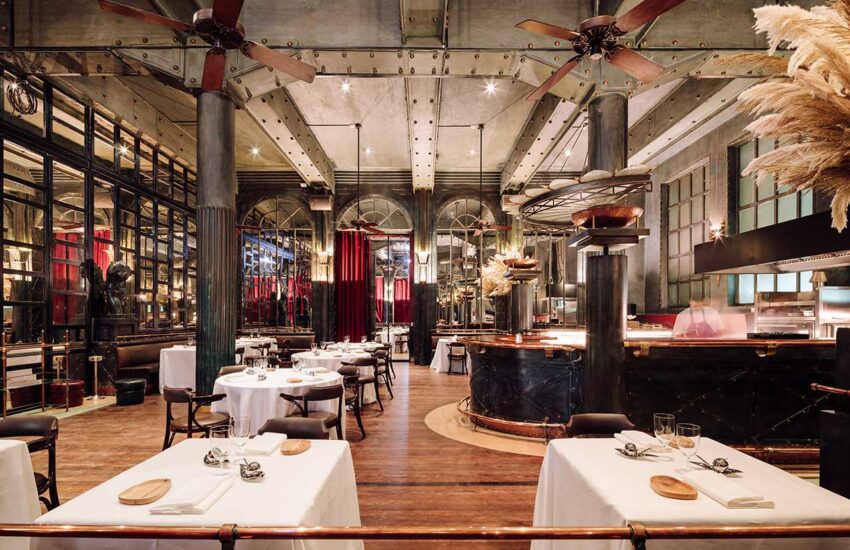Michelin starred restaurants are the height of culinary perfection, renowned around the world for their extraordinary quality and inventiveness. These awards, which come from the esteemed Michelin Guide, are given to businesses that show an unmatched dedication to culinary excellence. Originally published in 1926 by the tire firm Michelin, the Michelin Guide has grown to be the authoritative source, awarding stars to a limited number of eateries.
These stars act as a gastronomic seal of approval, pointing discriminating diners in the direction of unmatched culinary adventures. Three stars is the pinnacle of culinary excellence; each star denotes a distinct level of proficiency. In addition to culinary quality, Michelin starred restaurants are assessed based on artistic ability, technical proficiency, and regularity.
These restaurants create immersive experiences that entice the senses, with food that goes beyond simple nourishment. A trip into the sublime, where culinary creativity meets the greatest standards of excellence, is what discovering the world of Michelin starred restaurants promises.

Quick Navigation
The Development of the Michelin Guide
When stars were added to the Michelin Guide in 1926, it underwent a revolutionary transformation from its modest beginnings as a publication by the tire manufacturer Michelin in 1900. The handbook gave drivers information on lodging, restaurants, and mechanics in an effort to promote road trips. It developed into a highly respected culinary authority throughout time, and Michelin stars came to represent the pinnacle of culinary praise.
The Coveted Stars: Standards and Assessment
Michelin stars are not given out carelessly; rather, they are the product of a rigorous assessment procedure conducted by independent inspectors. These food experts examine every aspect of the eating experience, including innovation and consistency, as well as the quality of ingredients and technique. Obtaining one, two, or the highest possible three stars is a testament to an extraordinary dedication to the craft of cooking.
For instance, the three Michelin stars at the famed seafood restaurant Le Bernardin in Paris were earned via the restaurant’s unwavering commitment to flavor and presentation perfection.
Annual Disclosures: The Ratings Calendar of the Michelin Guide
The Michelin Guide’s yearly publication of revised ratings is one of its distinguishing features. The food industry eagerly awaits these announcements, which take place according to varied schedules for different areas. The Michelin Guides—the Paris, New York, and Tokyo guides, for example—each have their own star unveilings, which are significant events that have a lasting impact on the food world.
Read Also: 29 Best Scholarships In Korea For International Students
Beyond Gastronomic Praise: The Importance of Michelin Stars
Michelin stars are more than just honors; they are evidence of a restaurant’s commitment to provide a singular dining experience. Michelin stars are important for many reasons than just food; they affect restaurants’ business and reputation. With its three Michelin stars, Per Se in New York City, for example, has come to be associated with culinary extravagance and draws in sophisticated guests looking for an extraordinary culinary experience.
The Michelin Stars’ Global Reach
Despite having its beginnings in France, Michelin’s effect is very global. These days, Michelin starred restaurants are a worldwide phenomenon, with the guide encompassing Asia, the Americas, and other locations. This international accolade emphasizes how great culinary craftsmanship is liked and appreciated by people everywhere. Michelin starred restaurants, such as Tokyo’s Sukiyabashi Jiro and New York’s Eleven Madison Park, are cultural ambassadors of fine dining.
Michelin Stars: A Dynamic Nature of Gaining and Losing
Michelin starred restaurants operate in a changing world where tastes change and businesses have to change with the times to be at the top. Not only can stars be earned along the way, but they can also be lost. These changes are caused by a variety of circumstances, including as changes in leadership, changes in the direction of the cuisine, and variations in the general quality of the dining experience.
An illustration of the fleeting nature of Michelin stars is the famous El Bulli in Spain, which closed its doors after becoming a three-star culinary legend. In the meantime, new stars rise with places like Copenhagen’s Noma, which highlights the ever-changing tides inside the Michelin-starred constellation.
Traveling for Michelin-starred Experiences: Culinary Pilgrimages
Michelin stars are not merely a mark of distinction for ardent foodies; they are also invitations to go on gastronomic pilgrimages. Food tourism is booming, and dining at Michelin starred restaurants has become a global phenomenon. Foodies travel to renowned restaurants, like Modena, Italy’s Osteria Francescana, not simply for a meal but for a fully immersive experience that goes beyond the plate.
Read Also: Discover How to Apply for University in Canada | Step by Step Guide
Chefs and restaurateurs: The Effect
For chefs and restaurateurs, receiving or losing a Michelin star can have a significant impact. A chef can become a celebrity by getting a star, especially the coveted three, which can lead to partnerships, book agreements, and international fame. On the other hand, losing stars can be a humble experience that inspires reflection and self-improvement.
Think about Gordon Ramsay, whose London restaurant of the same name lost its three Michelin stars. Rather than give in to discouragement, the world-famous chef rebuilt his culinary empire with fresh endeavors and unwavering attention to quality.
Michelin Stars Serving as Cultural Envoys
Michelin starred restaurants act as cultural ambassadors in addition to being symbols of gastronomic excellence. They enhance culinary traditions by showcasing the creativity and diversity of world cuisines. For example, Bangkok’s Gaggan, which is well-known for its innovative Indian food, has received multiple Michelin stars, which has highlighted the city’s rise as a culinary destination.
The Michelin Stars’ Future
The future of Michelin starred restaurants looks full of excitement and innovation as palates around the world continue to grow and culinary landscapes change. There will be new discoveries in the kitchen, and the notion of what constitutes excellent food may change. It’s conceivable that the Michelin Guide will adjust in response to these developments to maintain its status as the gold standard for culinary excellence.
Read Also: Cardiff University Review | History, Tuition, Scholarships
What standards does the Michelin Guide apply when granting stars to eateries?
A thorough and anonymous inspection method is used by the Michelin Guide to rank restaurants and assign stars. The criteria emphasize the entire dining experience by encompassing a number of crucial components. Inspectors evaluate the consistency, value for money, inventiveness, competence in flavor combination, and quality of ingredients.
The coveted Michelin stars aren’t just about how fancy a restaurant is; they also honor a careful balancing act between culinary expertise and a dedication to providing an unforgettable dining experience.
How frequently do Michelin Guide ratings for Michelin starred restaurants get updated?
Every year, the Michelin Guide updates its ratings; however, local schedules may differ. An army of covert inspectors travels the world every year, stopping at eateries to review their products. Because of how carefully this process is carried out, the awards given to Michelin starred restaurants are kept up to date and accurately represent their current position in the food industry.
What role do Michelin stars play in the food industry?
In the culinary industry, Michelin stars are highly significant as they denote the pinnacle of recognition and status. A restaurant’s ability to produce outstanding food is demonstrated by merely one star, but two or three stars take it to the next level.
Michelin stars are more than just honors; they are a benchmark of unmatched quality and creativity for discriminating eaters. Achieving three Michelin stars is a career-defining accomplishment for chefs and restaurateurs, since it frequently results in greater recognition, higher demand, and a prestigious position within the international culinary community.

What variables influence the loss or acquisition of stars at Michelin starred restaurants over time?
Michelin starred restaurants can lose and acquire stars over time, yes. The Michelin Guide’s stringent standards must be continually met or exceeded by restaurants due to the ever-changing culinary landscape. Changes in quality, shifts in the overall dining experience, and shifts in the culinary direction are all factors that affect how many stars a restaurant receives or loses.
A restaurant may lose stars if any of these factors worsen, but it may gain stars if it maintains its high standards of creativity, dedication to quality, and culinary advancement.
Do Michelin starred restaurants exist solely in certain areas or are they well-known throughout the world?
Michelin starred restaurants are emblems of culinary brilliance that are worldwide recognized and not limited to any particular region. Despite its French roots, the Michelin Guide’s coverage has spread to many nations in Europe, Asia, the Americas, and beyond.
This worldwide reach highlights how well-known Michelin stars are, setting them as a standard of excellence that cuts across national and cultural barriers. Michelin starred restaurants are renowned for their outstanding contributions to the field of cuisine, whether they are located in the center of Paris, Tokyo, New York, or other culinary hotspots.
Recommended
- The University of Otago Review | History, Tuition, Admission, Programs
- Top 10 Harvard free online courses – Scholarships Hall
- Victoria University of Wellington | History, Tuition, Admission, Programs,
- 28 Free worksheets for kindergarten
How do restaurateurs and chefs feel about being awarded or denied a Michelin star?
The culinary scene itself is as diverse as the responses chefs and restaurateurs have when they are awarded or deprived of Michelin stars. A Michelin star is a great honor and a source of great satisfaction for someone who has worked so hard, been so creative, and been so dedicated to the culinary arts. It can improve the restaurant’s and the chef’s reputation by drawing in more customers and instilling a sense of pride in the culinary staff.
On the other hand, losing a Michelin star may be a difficult and humiliating event. It’s possible for chefs and restaurateurs to experience disappointment and a sense of loss. The Michelin guide’s inspectors reevaluate establishments that receive stars because they are subject to severe examination and may deem a fall in quality warranted.
But it’s important to remember that there is always hope because the food industry is so dynamic. When a chef or business loses a star, they usually get even more determined to win back that status via creative cooking and a constant pursuit of excellence.
SEE ALSO:
Trust you found our article on Michelin Starred Restaurants helpful. Follow our website for more interesting articles.

